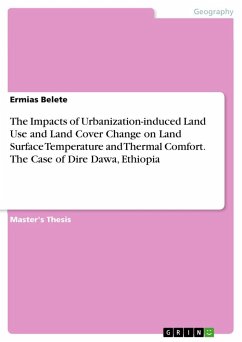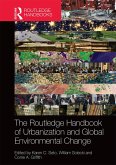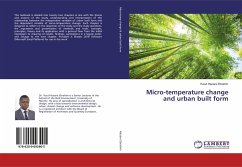Master's Thesis from the year 2023 in the subject Urban and Regional Planning, grade: Very Good, , course: Geo-Informatics Engineering, language: English, abstract: This study was focused on assessing an "Implications of Urbanization-Induced Land Use Land Cover Changes on Land Surface Temperature and Thermal Comfort in Dire Dawa City between 2000 and 2022". The City is experiencing rapid urbanization, and limitation of green area aesthetical values that has resulted in remarkable surface temperature. Despite this, until now, no evaluations have been duly executed pertaining to the thermal or ecological factors in Dire Dawa. The study utilized Landsat 5 (TM), Landsat 9 (OIL/TIRS) and MODIS 11A2 images which were obtained from USGS for the study area. To analyze and show results clearly, ArcGIS 10.8, ERDAS IMAGINE 2014, and Excel 2013 softwares were used. The LULC pattern was processed by supervised classification with the maximum likelihood classification algorithm and four major land use land cover (Built-up area, Barren land, Shrub land, and sparse vegetation) were identified. The biggest urban problem facing cities around the world today is the result of land use change induced by urbanization. Rapid urbanization, driven by demographic and economic growth, places additional demands on natural resources, leading to changes in land use, particularly in megacities. Due to urbanization and unplanned human activities, the vegetation of the earth's surface is in constant decline, leading to changes in the environment, especially in the earth's ecosystem at local, regional and global scales. Future increases in climate change and urbanization will exacerbate urban heat islands, especially during heatwaves. Similar to any other cities across the world, different urban areas in Ethiopia are affected by climate change. Dire Dawa city has experienced massive urbanization in terms of population growth, fastest rates of urbanization with a 50 percent growth rate and major changes in the LULC has been a drastic increase in areal extent and coverage. Additionally observed surface improvements such as urban growth, settlement expansion and Construction of new built up or dwelling units in the city, socioeconomic factors, particularly in the context of anthropogenic activities have modified and will continue to modify the case study's microclimate. Despite variations among kebeles, Dire Dawa has population density of 350 people per square kilometer and a growth rate of 4.42 %. As a result, such increasing changes are responsible for increasing surface temperatures, can cause and pose a threat to the city's microclimate.








